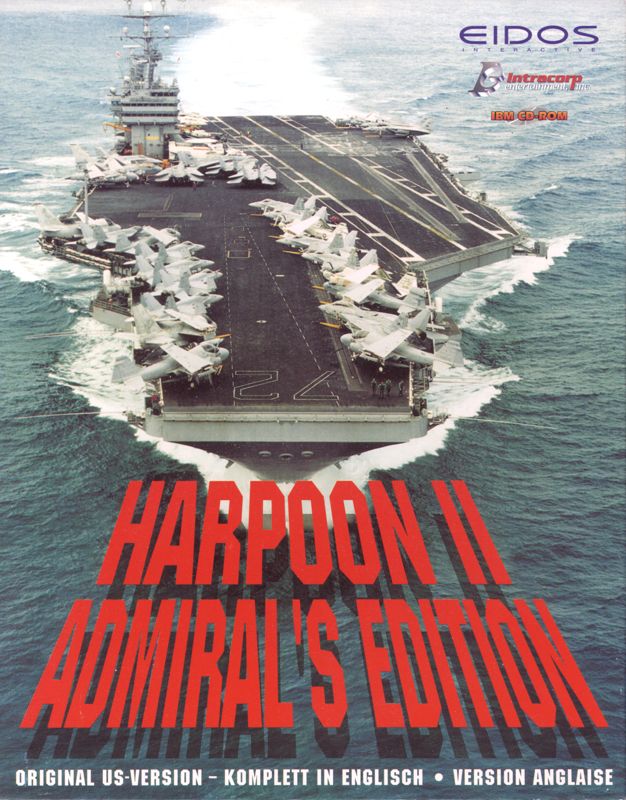Retro Replay Review
Gameplay
Harpoon II: Admiral’s Edition delivers an exceptionally deep naval strategy experience that challenges both veterans of the series and newcomers alike. At its core, the game retains the turn-based, map-driven mechanics of the original Harpoon II, but it expands upon them by including seven distinct battle sets ranging from Global Conflicts One through Three, to Cold War, Westpac, Regional Conflicts One, and the exclusive Regional Conflicts Two. This abundance of scenarios ensures that no two campaigns ever feel the same, whether you’re pitting modern carrier strike groups against each other or conducting submarine hunts in contested waters.
(HEY YOU!! We hope you enjoy! We try not to run ads. So basically, this is a very expensive hobby running this site. Please consider joining us for updates, forums, and more. Network w/ us to make some cash or friends while retro gaming, and you can win some free retro games for posting. Okay, carry on 👍)
The built-in scenario editor is one of the game’s crowning features, allowing you to craft your own naval engagements from scratch. You can place ships, submarines, aircraft, minefields, and coastal defenses wherever you like, adjust weather and time-of-day settings, and even script victory conditions. This level of customization transforms Harpoon II into a near-infinite sandbox—anything is possible, from hypothetical Cold War flashpoints to futuristic clashes in the Pacific.
Although the interface may feel dated to some, it rewards those willing to climb its learning curve. Detailed unit stat sheets, multi-tiered command structures, and realistic weapon modeling give each decision weight and ensure that tactics matter. The combination of historical and semi-fictional scenarios keeps your strategic thinking fresh, and the scenario builder opens the door to your own “what-if” naval narratives.
Graphics
Graphically, Harpoon II: Admiral’s Edition retains the utilitarian, top-down 2D style of its mid-90s origins. Unit icons are clearly distinguishable, with aircraft, ships, and subs each using unique silhouettes and color codes that help you track forces at a glance. Terrain features like coastlines, islands, and chokepoints are rendered clearly, and overlays (sonar ranges, radar coverage) can be toggled on for tactical clarity.
While there’s no flashy 3D engine here, the minimalist visuals work in the game’s favor by emphasizing information density over aesthetic flourish. In high-tempo engagements, you’ll appreciate the quick load times and unobstructed view of the strategic map. Admiral’s Edition does introduce higher-resolution icons and smoother zoom levels, making modern widescreen setups more comfortable without compromising performance.
Immersion comes not from lifelike graphics but from the depth of simulation. When a Harpoon missile arcs toward its target or a destroyer deploys countermeasures, the impact is felt through numbers and outcomes rather than visual spectacle. For players who prioritize substance and authenticity, the straightforward presentation is more than sufficient.
Story
Unlike story-driven naval games, Harpoon II: Admiral’s Edition focuses on sandbox and scenario-based play instead of a linear narrative. Each of the seven campaign sets—Global Conflicts One, Two, Three, Cold War, Westpac, Regional Conflicts One, and Regional Conflicts Two—serves as a thematic backdrop, offering hypothetical or historically inspired engagements. These scenarios don’t have cutscenes or scripted characters but instead place you in the role of an admiral with a fleet to command.
Scenarios range from large-scale, multi-national war games pitting NATO and Warsaw Pact fleets against each other, to regional skirmishes in East Asia, the Persian Gulf, or West Pacific waters. While there’s no overarching plot tying all these theaters together, the contextual briefs for each mission provide enough political and military framing to make your objectives feel consequential.
The real narrative potential lies in the scenario editor: you can build a campaign about a geopolitical crisis of your own design or recreate a forgotten naval standoff from the Cold War. This open-ended approach means that, in a sense, the story is yours to write, as you craft diplomatic backstories, deploy forces, and set victory conditions that resonate with your personal vision of maritime conflict.
Overall Experience
Harpoon II: Admiral’s Edition offers one of the most comprehensive naval warfare simulations available, combining the original game with seven expansive battle sets. Its depth of detail—from sensor detection algorithms to weapon ranges and damage modeling—makes it a must-have for strategy fans who relish meticulous planning and real-world tactics. It’s not plug-and-play friendly, but for those eager to master its systems, the rewards are substantial.
The inclusion of the scenario editor elevates the package, granting near-unlimited replayability. Whether replaying classic Cold War face-offs, testing new doctrines in Westpac waters, or inventing hypothetical sea battles, you’ll find endless challenges. Multiplayer and hotseat modes further extend longevity, allowing you and friends to pit your strategic wits against each other.
Ultimately, Admiral’s Edition caters to a niche but dedicated audience. If you value deep simulation, historical authenticity, and creative freedom over cinematic presentation, this collection represents outstanding value. Even decades after its initial release, Harpoon II continues to set the bar for naval strategy, making this Admiral’s Edition a worthwhile purchase for anyone serious about command at sea.
 Retro Replay Retro Replay gaming reviews, news, emulation, geek stuff and more!
Retro Replay Retro Replay gaming reviews, news, emulation, geek stuff and more!




Reviews
There are no reviews yet.